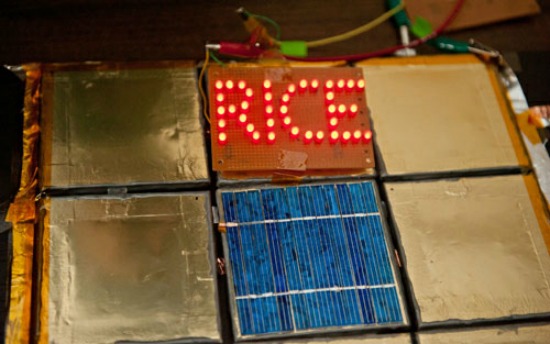Our Daily Juice
Batteries, so much a part of our daily lives, are being transformed. Now scientists say they’ve created one out of spray paint
![]()

Spray paint turns ceramic tiles into a battery. Photo courtesy of Rice University
Until a week ago, my relationship with batteries had been purely prosaic. Sure, I charged cell phone and laptop batteries every night, but with no more deliberation than brushing my teeth or skipping past Jay Leno’s monologue.
Then came the Derecho of 2012, and I, like millions of other Americans, lost power for days that seemed like weeks. And I, like so many others, succumbed to juice hysteria, an obsession with staking claims to working outlets in public places–Starbucks, libraries, shopping mall food courts–so that we could bring our devices back to life.
Today I have power again. I also have a far deeper appreciation for all things electrochemical. Because in the world we now live, battery life is a very big deal, whether it’s to keep us connected in the day-to-day or the key to the future of electric vehicles and renewable energy.
As it turned out, last week was a momentous one for batteries. The day before the storm that crippled Washington, a study was published in Nature Scientific Reports revealing that a working battery had been created simply by spray-painting a surface. That’s right, power from paint.
Hard to believe? Here’s how a team of scientists at Rice University in Texas did it. They converted into liquids the five components of a lithium ion battery–a positive current collector, a negative current collector, a cathode, an anode and a separator–and then sprayed each, in extremely thin layers, over a variety of surfaces. They painted bathroom tiles. They painted glass and stainless steel. They painted flexible film. They painted a ceramic beer mug. All were able to carry a charge.
They even connected the bathroom tiles to a solar cell. They were able to keep an LED display–it spelled out RICE–glowing for six hours.
We’re still a long way off from you being able to charge your smart phone with a beer mug, but this could be a game changer in terms of opening up all kinds of new ways to store energy. And that could be a boon to solar power as a source of energy within our homes.
As Neelam Singh, one the Rice researchers put it, “You could turn your home into a battery.”
An Edison comeback?
Also last week, researchers at Stanford announced that they’ve given new life to the nickel-iron battery that Thomas Edison once hoped would power cars. Roughly 100 years ago, Edison was a big believer in electric cars. But batteries back then weren’t up to the job, so he lost out to his friend Henry Ford and his gas-powered engine.
The problem with those nickel-iron batteries was that they were painfully slow to charge and discharge. But the Stanford group, using nanotechnology rather than simply mixing nickel and iron, has been able to make the battery function 1,000 times faster than the old version. It took only two minutes to charge a small prototype battery.
Nickel-iron batteries aren’t strong enough to power today’s electric cars, but if combined with the lithium ion model now being used, they could dramatically reduce the time required to charge an electric vehicle, which now takes hours. This setup also could allow a vehicle to actually capture the energy created when you applied the brakes. And the fast discharge rate would make it easier for a car to accelerate.
At the same time, IBM is among several companies taking on the dreaded range anxiety–the fear having your electric car run out of juice in the middle of nowhere. The typical range now is 100 miles per charge. But IBM is aiming to raise that to 500 miles by refining what’s known as a lithium air battery.
Instead of having oxygen built into the battery, lithium air models would generate power by taking in oxygen from the outside air. That would make them significantly smaller and lighter than the lithium ion batteries now being used.
IBM has been able to get the concept to work in a lab. But, time for a reality check. It likely will be at least another 10 years before it could function in a car.
Who knows, by then you may be able to charge your car with your spray-painted mailbox, which will, no doubt, be needing a new reason for being.
Charging up
Here’s more recent news about batteries:
- Cutting the cord: It’s only a matter of time before electric vehicle owners won’t need to plug in their cars to charge up. Instead, they’ll be able to do it wirelessly by parking over mats that do the work.
- Put that in the bank: A giant bank of batteries installed near the tracks has started to save Philadelphia’s subway system lots of money. It captures energy created when trains slow down at a station and puts it back on the line to help them accelerate.
- I wear the body electric: Two University of South Carolina engineers were able to turn a store-bought T-shirt into fabric that could store an electrical charge.
- The slow ride to freedom: Inmates at a prison in Brazil can reduce their sentences by a day for every 16 hours they ride a stationary bike that charges batteries. Their pedaling powers streetlights in a nearby town.
- Giving new meaning to the term “button nose”: And now the downside of the battery boom: According to a study published in the journal Pediatrics, the number of kids going to emergency rooms after swallowing those little button batteries– or sticking them in their noses or ears–has doubled in the past 20 years.
Video bonus Here’s a little blast from the past, when TV commercials took on the challenge of trying to make batteries funny.
More from Smithsonian.com:
/https://tf-cmsv2-smithsonianmag-media.s3.amazonaws.com/accounts/headshot/randy-rieland-240.png)
/https://tf-cmsv2-smithsonianmag-media.s3.amazonaws.com/accounts/headshot/randy-rieland-240.png)